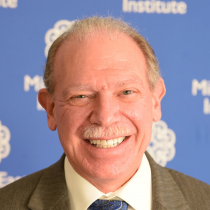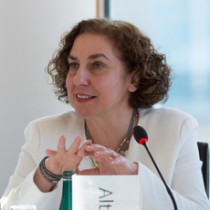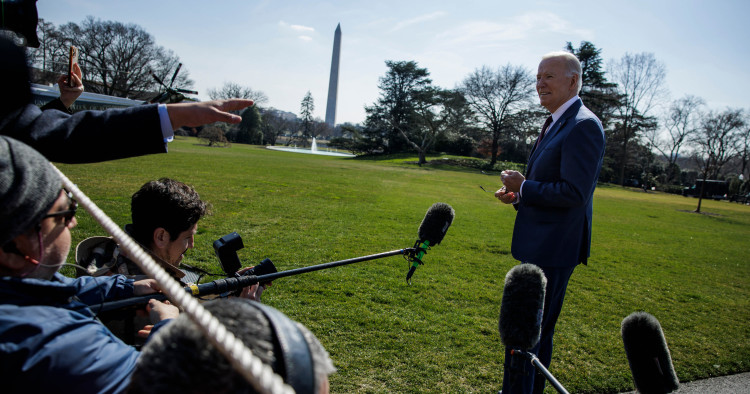Contents:
- How much does the Biden administration truly prioritize a two-state solution?
- Wither Abbas? Palestinian president clings to power as Israel concludes Hamas will survive
- Pakistan’s national elections are looking more and more like a national disaster
- With visits to Qatar and the UAE, Modi underscores India’s core foreign policy objectives for the Gulf
- Erdoğan’s visit to Cairo: A new phase in Egypt-Turkey reconciliation
- The new COP climate "troika": COP28 may be over, but the UAE remains onboard
How much does the Biden administration truly prioritize a two-state solution?
Brian Katulis
Senior Fellow for U.S. Foreign Policy and Senior Advisor to the President

-
A confluence of dynamics already in motion makes the next few weeks a crucial and defining period for the Israeli-Palestinian conflict and wider Middle East stability.
-
It remains to be seen whether the Biden administration is prepared to dedicate the key resources and policy moves needed to achieve progress on its stated goals for the Middle East, including de-escalation and a path toward a two-state solution for Israelis and Palestinians.
Negotiations between Israel and Hamas to achieve a temporary cease-fire and release of hostages failed yet again this past week. The lack of diplomatic success prompted Israeli war cabinet minister Benny Gantz to threaten to expand Israel’s ground offensive to Rafah, in southern Gaza along the border with Egypt, by the start of the Muslim holy month of Ramadan, in the second week of March.
The Biden administration urged Israel to drop its plans for expanding the ground offensive into Rafah, where most of the Palestinians displaced in Gaza have moved since the start of the war more than four months ago. At the same time, the United States vetoed a United Nations resolution put forward this morning by Algeria calling for an immediate cease-fire in the Israel-Hamas war, and instead proposed an alternative measure with a different formulation aimed at sending a message about the risks of a Rafah military offensive.
The next three weeks are increasingly shaping up to be a crucial and defining period in the Gaza war and more broadly in the Middle East. Worries are growing that the ongoing war and simmering tensions across the region could spike substantially in March and April, when Muslim, Jewish, and Christian holidays are set to take place. Amid talk inside of the Israeli government about setting limits on Muslims’ access to holy sites in Jerusalem, and with ongoing tensions in the West Bank and across the region, the Biden administration is worried about more flare-ups that could ignite a wider regional conflagration at a time when it has stepped up US military actions against Iran-backed groups in Yemen, the Red Sea, Syria, and Iraq.
Against the backdrop of this short-term crisis management, the Biden administration is still dutifully working to advance a long-game agenda to support the idea of a two-state solution to the Israeli-Palestinian conflict. Israel’s current leaders, including Prime Minister Benjamin Netanyahu, have rejected this notion, saying it would be a “huge reward for terrorism.” Other key regional actors, namely Hamas and Iran, also reject the two-state solution idea.
This unfavorable landscape raises an important question for the Biden administration: How much does it truly prioritize progress toward a two-state solution between Israelis and Palestinians? After all, the combination of the grim realities on the ground plus political dynamics in the region make this a mighty tall order to achieve any progress anytime soon.
William Burns, President Joe Biden’s Central Intelligence Agency (CIA) director who has recently been a key figure in the negotiations between Israel and Hamas, wrote in his 2019 memoir, The Back Channel, that one mistake made in US foreign policy is to apply minimalist means to achieve maximalist ends. The crisis of efficacy in US foreign policy — stating goals like achieving a two-state solution and then repeatedly falling short — has a deleterious impact on America’s ability to shape and influence events around the world.
The next few weeks are, thus, shaping up to be an important test of the Biden administration’s efforts to achieve results and see some progress toward the goals it has set for itself in the Middle East.
Follow: @Katulis
Wither Abbas? Palestinian president clings to power as Israel concludes Hamas will survive
Nasir Almasri
Graduate Fellow, Program on Palestine and Palestinian-Israeli Affairs

-
Palestinian President Mahmoud Abbas’ limited responses to the Gaza conflict and struggle to remain relevant throughout much of the war were finally broken when he visited Qatar this past week in an attempt to place himself at the center of negotiations over the post-war order in Gaza and to publicly pressure Hamas to accept a cease-fire and release captives.
-
Any power-sharing deal brokered between Hamas and the Palestinian Authority would be unlikely to leave Abbas with wide-ranging powers, inevitably limiting his ability to act as a broker between Palestinians and Israel.
Prior to Oct. 7, Palestinian president and Fatah leader Mahmoud Abbas was already wildly unpopular, with over 90% of Palestinians desiring alternative leadership. Abbas was strongly disliked even among Fatah supporters, and the Palestinian Authority’s (PA) legitimacy declined sharply among Palestinians more generally. The latter trend had become especially evident in the West Bank, where mounting violence — including from the al-Aqsa Martyrs’ Brigade, a militant faction of Fatah that has gained independence — was a serious problem for both Israel and the PA.
The 88-year-old president’s limited response to the Gaza conflict and struggle to remain relevant throughout much of the war were finally broken when he visited Qatar this past week in an attempt to place himself at the center of negotiations over the post-war order in Gaza and to publicly pressure Hamas to accept a cease-fire and release captives. Though this has spurred public and private conversations about who might become the new Palestinian prime minister, it remains to be seen if the end of the war will bring an end to President Abbas’ time in power. Indeed, his insistence on remaining in power is now complicating US reconstruction plans in Gaza that include the PA but likely exclude Abbas.
Hamas, on the other hand, appears to be in a relative position of strength politically when compared to Abbas, despite Israel’s utter devastation of Gaza. Leaks from the highest levels of the Israeli military command suggest that eliminating Hamas is unlikely, and more recent Israel Defense Forces (IDF) intelligence reports indicate that Hamas will survive the war and maintain its popularity among Gazans.
While news stories have surfaced that Hamas might be willing to join the PA in something like a consensus government and accept a two-state solution, others indicate only that it is willing to negotiate the future of Palestinian politics with Fatah and other groups independently of the United States and Israel. Indeed, Hamas called for elections and — in coordination with other Palestinian factions — released a statement rejecting “day after” discussions about Gaza. Moreover, it has demanded support from the League of Arab States, the Organization of Islamic Cooperation, and the United Nations to rebuild Gaza while providing Palestinians the autonomy to reconcile their differences and chart a path forward. Though elections seem a distant possibility, polls indicate that Hamas’ Ismail Haniyeh would win a significant victory over Abbas, 78% to 16%. A power-sharing arrangement with Hamas also seems unlikely.
Yet it appears that Palestinians in the West Bank, the Israeli government, the US, and the Arab regimes involved in negotiations do not see continued benefit from Abbas. It remains to be seen if he can maneuver through this political crisis, if he can convince the US and Israel to enforce his hold on power, or if he will wither away instead.
Pakistan’s national elections are looking more and more like a national disaster
Marvin G. Weinbaum
Director, Afghanistan and Pakistan Studies

-
Nearly two weeks on from the Feb. 8 elections, Pakistan’s political landscape remains in flux, with recent revelations of ballot tampering and vote rigging highlighting the deep failings of its electoral process and removing the possibility of a smooth transition of power.
-
A deadlock has emerged in negotiations over government formation between the Pakistan Muslim League-Nawaz and the Pakistan People’s Party, fueling speculation about the possible return of Imran Khan’s Tehreek-e-Insaf party as part of a national unity government, as well as concerns that the elections might be declared null and void.
Up until a week ago it appeared that a widely foreseen post-election narrative was unfolding. Although Imran Khan’s Tehreek-e-Insaf (PTI) party’s scoring of an election plurality had thrown things somewhat out of joint, Nawaz Sharif’s Pakistan Muslim League-Nawaz (PML-N) seemed poised to form the new government. Smaller parties and uncommitted independents anxious to be aligned with the winning side were predictably falling into line with the party of the three-time prime minister. The military, which had suffered a reputational blow with its unaccustomed failure to skillfully manipulate the election’s outcome, seemed to be staging a comeback with its hand in the formation of a Nawaz-led coalition. Meanwhile, an imprisoned Khan seemed helpless to derail the establishment’s prescribed political script.
And then the political landscape swiftly changed, revealing the deep failings of Pakistan’s electoral process and democratic order. Reports of ballot tampering have surfaced, casting doubt on the integrity of the election. The possibility of repolling looms as election officials acknowledge corruption within the electoral system and the country’s top judiciary is contemplating intervention. Massive protest demonstrations, liable to result in violence, are in the making. And there are signs of discontent within the ranks over the military’s handling of Khan.
New developments have further upset the possibility of a smooth transition of power. The commissioner of Rawalpindi, Islamabad’s twin city and home to the Pakistan Army’s headquarters, has publicly admitted to widespread rigging of the election. He alleges the involvement of Pakistan’s chief elections commissioner and the country’s chief justice, among others in the state bureaucracy. Charging the military as well with interference, Khan is challenging the election results in the courts in virtually all of the 85 contests lost by those who ran as independent surrogates for his banned party. Meanwhile, previous PTI loyalists who had broken from the party to run independently are reportedly thinking of returning to the fold.
The planned demonstrations by the PTI, along with other disgruntled parties, pose a significant risk not only to political stability but also to an already precarious economy. Caretaker Prime Minister Anwaar ul-Haq Kakar has warned of “hostile forces [...] trying to spread anarchy and disorder.” Despite Khan’s call that demonstrations remain peaceful, spokespeople for the PTI have warned that countrywide protests may see a repeat of the events of May 9, 2023. On that day, following Khan’s arrest at the Islamabad High Court, demonstrations by PTI loyalists turned violent, and they attacked military installations with the believed intention of staging a coup against the Islamabad government.
Reflecting the complicated efforts to form a government, a deadlock has emerged in negotiations between the PML-N and the Pakistan People’s Party (PPP), which had won the third largest number of seats in the National Assembly. The PPP in its demand for the country’s presidency and for other constitutional positions has thus far been rebuffed by the PML-N. For its part, the PML-N now may be having second thoughts about forming a weak coalition government with the PPP. A disappointed PPP has left open the possibility that it might ally with the PTI. Though Khan has in the past rejected an alliance with either of the mainstream parties, his position seems to be softening. Speculation about the PTI returning to power has grown, especially since it announced Omar Ayub Khan as its stand-in choice for the post of prime minister; he is the grandson of Field Marshal Ayub Khan, the general who ruled the country for 10 years under imposed martial law in the late 1950s and 1960s.
If the momentum behind Khan continues to build, the possibility of forming a national unity government that includes the PTI may look increasingly attractive, even to the military establishment. But if the deadlock in forming a government persists, the courts, backed by the generals, could declare the election results null and void and direct the current caretaker system to stay in office until fresh elections can be held. Quite possibly, this action could trigger massive public resistance, leading the military to declare emergency rule or martial law.
Research assistant Naad-e-Ali Sulehria contributed to this piece.
Follow: @mgweinbaum
With visits to Qatar and the UAE, Modi underscores India’s core foreign policy objectives for the Gulf
Gerald M. Feierstein
Distinguished Sr. Fellow on U.S. Diplomacy; Director, Arabian Peninsula Affairs

-
Indian Prime Minister Narendra Modi made his 13th visit to the Gulf last week, reflecting the fact that strong relations with the Gulf Cooperation Council are critical for both India’s foreign and domestic policies.
-
Bolstering India’s relations with the Gulf — ensuring that India has alternatives to Russia for meeting its energy needs while moderating China’s economic and political advances in the Gulf — is also a critical element of the US strategy of confronting regional challenges from Moscow and Beijing.
As India’s prime minister, Narendra Modi has long lavished attention on his country’s critical regional relationships in the Gulf. His visit to Qatar and the United Arab Emirates last week, Feb. 13-15, marks his 13th trip to the six Gulf Cooperation Council (GCC) member states since becoming prime minister a decade ago, including seven to the UAE, which had not received an Indian head of government in 34 years before Modi’s first arrival in 2015.
For India, strong relations with the GCC are critical both for its foreign and domestic policies. The Gulf states are collectively India’s largest trading partner, providing some 60% of India’s oil imports. Qatar is its largest source of liquified natural gas. Similarly, the Gulf states are significant sources of foreign direct investment for the Indian economy. Saudi Crown Prince Mohammed bin Salman pledged that the Saudis would invest $100 billion in Indian enterprises when he visited in 2019, and the UAE has committed to provide $75 billion for India’s infrastructure sector.
Counter-balancing China’s role as a Gulf economic player, India’s growing presence not only as an economic but also as a defense and security partner for the Gulf states is increasingly important. The formation of the India-Middle East-Europe Economic Corridor (IMEC) has the potential to compete with China’s Belt and Road Initiative (BRI), while the I2U2 initiative (joining India, Israel, the UAE, and the United States) expands India’s stabilizing role in West Asia. Meanwhile, last year’s invitation to Saudi Arabia and the UAE to join the BRICS grouping (heretofore, Brazil, Russia, India, China, and South Africa) adds to India’s presence, strengthening the group of moderate, Western-oriented states in that organization.
By focusing his foreign policy initiatives on relations with the GCC, Modi also hasn’t lost sight of the positive impact his relationship-building has at home. With some 9 million Indian nationals resident in the Gulf, nearly one-third of India’s $90 billion in foreign remittances come from the region. At the same time, Modi’s robust contacts with Gulf leaders enhance the status and security of the Indian population there. Notably, during his visit to Abu Dhabi, Modi took time to inaugurate the first-ever Hindu temple in the UAE. Given India’s large Muslim population, strong ties to the Gulf are also an important policy initiative for that community.
Bolstering India’s relations with the Gulf — ensuring that India has alternatives to Russia for meeting its energy needs while moderating China’s economic and political advances in the Gulf — is also a critical element of the US strategy of confronting regional challenges from Moscow and Beijing. With Washington’s regional position complicated by the ongoing Israel-Hamas conflict in Gaza, the growing links between New Delhi and the GCC states are likely to play a central role in the evolving US approach to its regional political, economic, and security interests.
Erdoğan’s visit to Cairo: A new phase in Egypt-Turkey reconciliation

Meliha Benli Altunışık
Non-Resident Scholar, Turkey Program
-
Turkish President Recep Tayyip Erdoğan's Feb. 14 visit to Cairo marked a new phase in the normalization of relations between Egypt and Turkey, a several-year-long process driven by domestic and regional calculations on both sides.
-
President Erdoğan’s visit focused on three main areas: further expansion of economic ties, the possibility of increased cooperation in the defense industry, and talks over the ongoing Israel- Gaza war as Turkey seeks a role in the emerging post-conflict constellation.
The normalization of relations between Egypt and Turkey reached a new level with Turkish President Recep Tayyip Erdoğan’s visit to Cairo on Feb. 14, 2024. After years of friction, the two countries had started a normalization process in 2021, mainly on Turkey’s initiative. The process moved slowly until the symbolic public handshake between the two leaders at the FIFA soccer World Cup in Qatar, in November 2022. The push for normalization stemmed from domestic and regional calculations on both sides and led to closer political and economic ties. Turkey’s desire not to be isolated in the evolving regional order after the start of the normalization wave with the Abraham Accords and in the Eastern Mediterranean played a role. Egypt’s economic needs and its quest to diversify its relations in the emerging regional order after the Abraham Accords were important factors in facilitating this shift as well. The narrowing of differences in the case of Libya, which had previously been a major point of contention, also had a significant impact. In particular, the shift in Egyptian policy from supporting Khalifa Hifter, the self-proclaimed head of the Libyan National Army who had failed to unseat the Tripoli government in the civil war, to reaching out to the Turkish-backed, Tripoli-based Government of National Unity opened up opportunities for rapprochement. As a result, in July 2023, the two sides appointed ambassadors for the first time in a decade.
President Erdoğan’s recent visit focused on three areas of cooperation. First was the further expansion of economic ties, which have already benefited from normalization with $10 billion in trade and $3 billion in Turkish investment. Second was the possibility of increased cooperation in the defense industry, which has emerged as a new element in the bilateral relationship. Third, and more importantly, the visit took place in the context of the ongoing Israel-Gaza war. Cooperation with Egypt appears to be important for Turkey, which is seeking a role in the emerging post-conflict constellation by acting as one of the “guarantors” in any deal reached over Gaza. Thus, Erdoğan’s visit to Cairo marks a new phase in bilateral relations.
The new COP climate “troika”: COP28 may be over, but the UAE remains onboard
Mohammed Mahmoud
Senior Fellow and Director of the Climate and Water Program

-
Consecutive COP meeting hosts United Arab Emirates, Azerbaijan, and Brazil unite to form a first-of-its-kind climate troika.
-
This coalition demonstrates a desperate commitment to maintaining climate action progress from COP meetings in the face of the escalating severity of climate change impacts.
Earlier last week, the United Arab Emirates, Azerbaijan, and Brazil — respectively, the hosts of the recently concluded United Nations Climate Change Conference (28th Conference of the Parties, COP28) and the forthcoming COP29 and COP30 meetings — announced that they would form a COP climate “troika,” principally to maintain the momentum for dedicated climate action set this past December at the climate summit in Dubai. Under the UAE’s purview, COP28 saw progress on a number of fronts, such as on climate financing and a global commitment to transition away from fossil fuels. Even prior to the troika announcement, the UAE remained very much engaged in the COP process, as the country continues to retain the role of COP president until that responsibility passes to Azerbaijan at the start of COP29. And while it’s not unusual for consecutive COP hosts to work together in the period between their respective climate conferences, much like what Egypt and the UAE did between COP27 and COP28, this is the first time that three COP hosts will closely coordinate their actions and agendas over the timeframe spanning their COP meetings.
This new approach offers several advantages. It helps Azerbaijan immensely, as its COP29 hosting duties were not confirmed until COP28, leaving Baku with a much shorter planning period than is usually the case for an upcoming COP host. Another advantage for Azerbaijan is that this troika will help prop up a climate conference saddled between two consequential COPs. Besides the slew of climate action announcements that came out of last year’s meeting in Dubai, COP28 was also the highest-attended COP to date. COP30, in 2025, is similarly expected to be a high-profile meeting with ambitious objectives, given Brazil’s (and President Lula de Silva’s) commitment to the environmental and biodiversity side of the climate crisis. It is even Brazil’s intention to host the meeting in the Amazon, in the city of Belém of Pará.
Finally, this partnership allows for the progress achieved at COP28, and whatever additional measures come out of COP29, to carry through to COP30, limiting the likelihood of disjointed agendas and abandoned initiatives. But most importantly, this troika can conjunctively hold the global parties to the Paris Agreement accountable to meeting the COP commitments set forth regarding energy transition, climate financing, and adaptation so that the goal of keeping future global warming below 1.5 and 2 degrees Celsius can still be possible. As 2023 — the hottest year on record — illustrated, the window for effectively curbing the current alarming trajectory of climate change is closing faster than we may have originally thought.
Photo: Samuel Corum/Sipa/Bloomberg via Getty Images
The Middle East Institute (MEI) is an independent, non-partisan, non-for-profit, educational organization. It does not engage in advocacy and its scholars’ opinions are their own. MEI welcomes financial donations, but retains sole editorial control over its work and its publications reflect only the authors’ views. For a listing of MEI donors, please click here.













